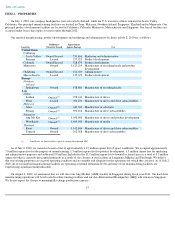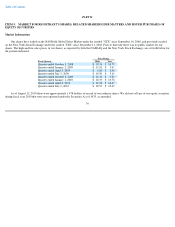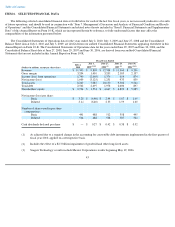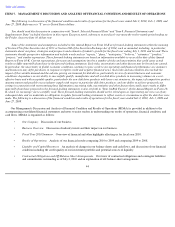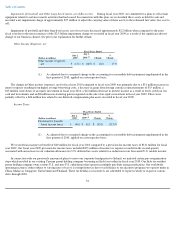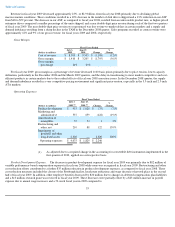Seagate 2009 Annual Report Download - page 49
Download and view the complete annual report
Please find page 49 of the 2009 Seagate annual report below. You can navigate through the pages in the report by either clicking on the pages listed below, or by using the keyword search tool below to find specific information within the annual report.
Table of Contents
• few new product introductions when multiple competitors have comparable or alternative product offerings;
•
temporary imbalances between industry supply and demand; and
• seasonally weaker demand, which may cause excess supply.
Disk drive manufacturers typically attempt to offset price erosion with an improved mix of disk drive products characterized by higher
capacity, better performance and additional feature sets and/or product cost reductions. To remain competitive, we believe it will be necessary to
continue to reduce prices as well as introduce new product offerings that utilize advanced technologies ahead of our competitors in order to take
advantage of potentially higher initial profit margins and reduced cost structure on these new products.
We experienced muted price erosion for the first nine months of fiscal year 2010 as our industry experienced unmet demand due to
industry-wide supply constraints during the first half of fiscal year 2010, and a relatively balanced supply and demand environment during the
March 2010 quarter. However, in the June 2010 quarter, industry supply exceeded demand and resulted in an increase in price erosion to levels
typical of a June quarter.
Seasonality
The disk drive industry traditionally experiences seasonal variability in demand with higher levels of demand in the second half of the
calendar year. This seasonality is driven by consumer spending in the back-to-school season from late summer to fall and the traditional holiday
shopping season from fall to winter. In addition, corporate demand is typically higher during the second half of the calendar year. For most of
fiscal year 2010, our industry observed a muted seasonal pattern as the hard disk drive industry experienced unmet demand due to industry-wide
supply constraints, while in the March 2010 quarter supply and demand were relatively balanced. However, in the June 2010 quarter, industry
supply exceeded demand, which we believe reflected a return to seasonal patterns typical of a June quarter.
Disk Drive Industry Consolidation
Due to the significant challenges posed by the need to continually innovate and improve manufacturing efficiency and the continued
demands on capital and research and development investments required to do so, the disk drive industry has undergone significant consolidation
as disk drive manufacturers and component manufacturers merged with other companies or exited the industry. The trend toward consolidation
is more pronounced during times of macroeconomic contraction. For example, Toshiba Corporation acquired Fujitsu Limited's hard disk drive
business in October 2009. The increasing technological challenges, associated levels of investment and competitive necessity of large-scale
operations may also drive future industry consolidation. Additionally, we may in the future face indirect competition from customers who from
time to time evaluate whether to offer electronic data storage products that may compete with our products.
Suppliers of Components and Industry Constraints
Due to industry consolidation, there are a limited number of independent suppliers of components, such as recording heads and media,
available to disk drive manufacturers. Vertically integrated disk drive manufacturers, who manufacture their own components, are less
dependent on external component suppliers than less vertically integrated disk drive manufacturers.
We believe the supply chain was generally tight for the industry during most of fiscal year 2010. Availability of glass substrates, finished
media and heads improved during the June 2010 quarter. However, supply of these critical components is still expected to be generally tight for
the second half of the 2010 calendar year, reflecting typical seasonal patterns.
47


